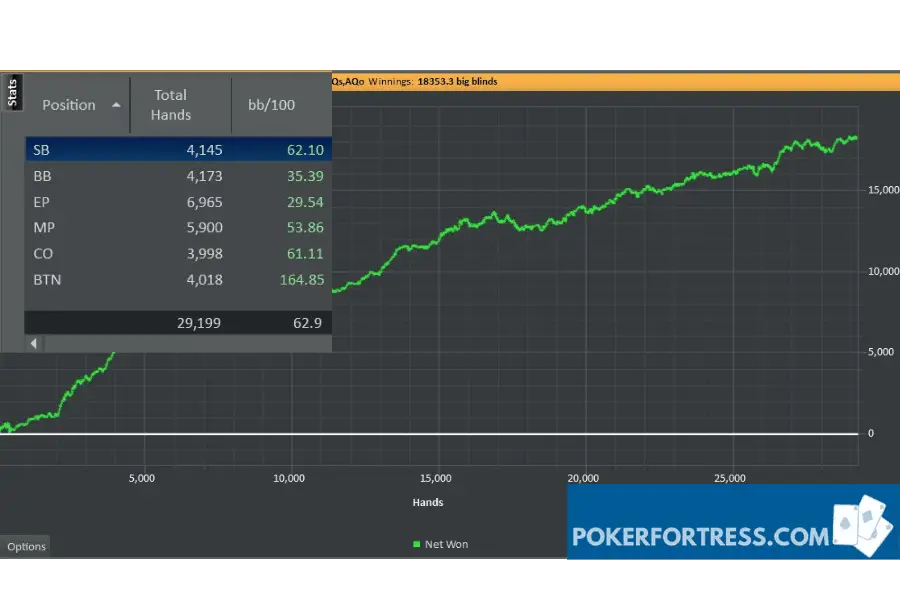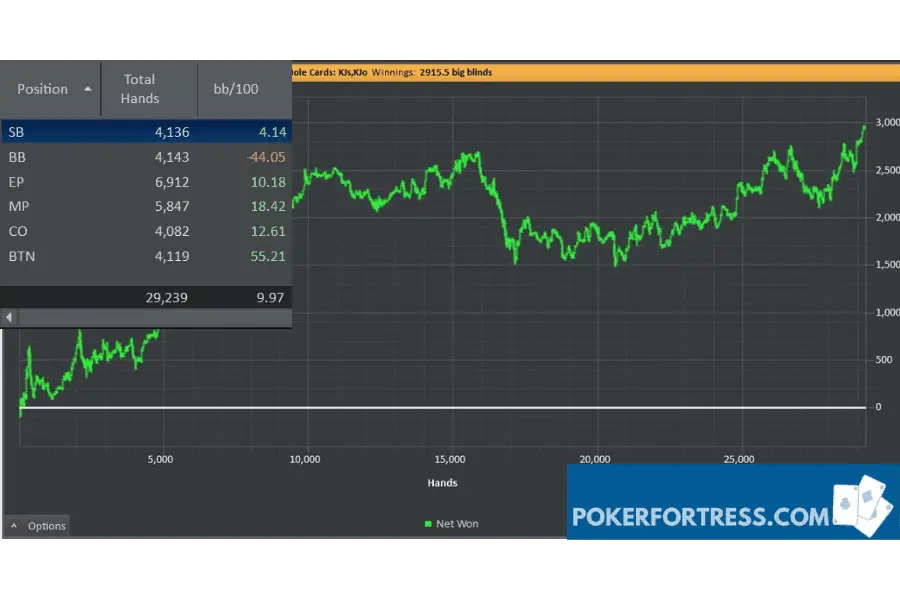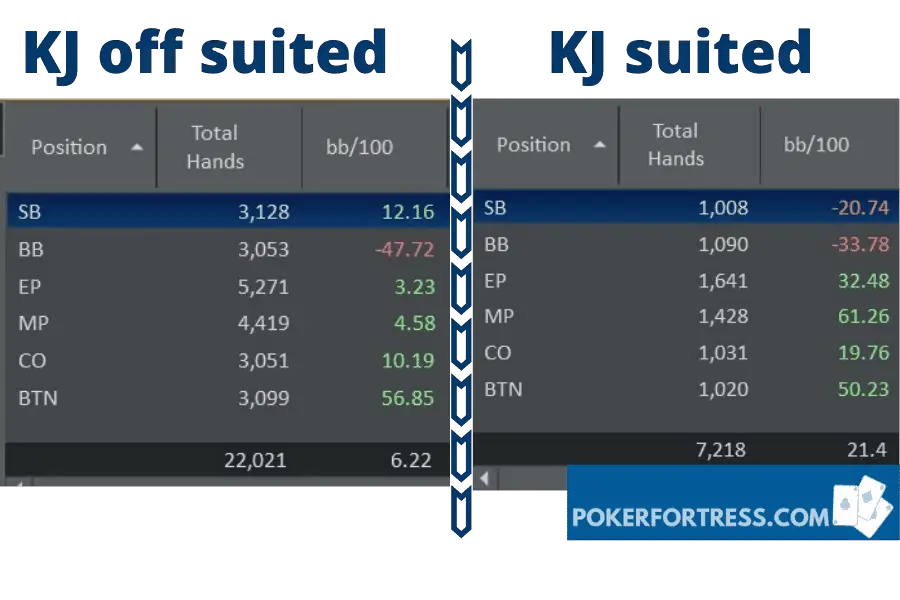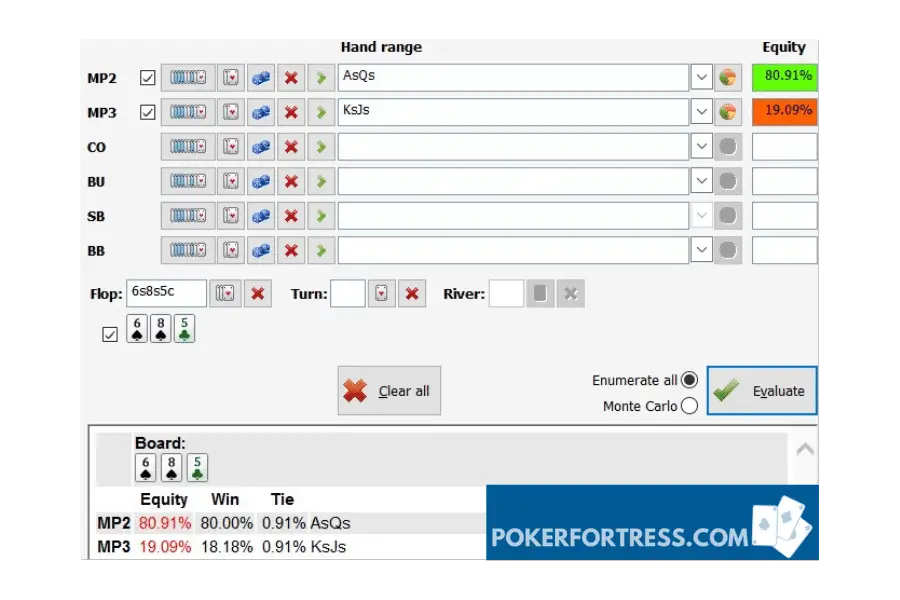Today I will show you how much better ace-queen actually is when we compare it to king-jack. You might think that the preflop difference is not that big. This might very well be the case, but this preflop edge accumulates in postflop spots.

This holds true for many hands (one of the exceptions are small pocket pairs for example, where your playability goes down if you don’t improve on the flop), small differences preflop, make a huge difference in winrate postflop. Therefore having solid fundamentals with correct preflop opens is a must.
Unlike in a scenario with Ace-King (AK) vs. pocket deuces (22) where 22 is a favorite preflop but postflop AK is a better hand to have, when we hold KJ, we don’t improve our chances to win postflop.
Winrate Breakdown of AQ vs. KJ

AQ is a very good hand in Texas Holdem. Once it hits a pair, it dominates many other top pair hands. The only hand that it needs to be careful about is AK. The winrate confirms that. Ace-Queen (AQ) makes a lot of money. The winnings are pretty consistent, with no huge swings.
King Jack (KJ), on the other hand, is not such a great hand anymore. It is still a winning hand and it makes sense to play it in many scenarios – check the image a bit below.. We still make money with KJ, but winrate is considerably lower than with AQ. This naturally means that swings become bigger, and even at my sample, you can see that the graph doesn’t look smooth anymore. It has a lot more ups and downs.
Ace Queen (AQ) vs. King Jack (KJ) preflop

Ace-Queen has an equity advantage against King Jack. 62.5% vs. 37.5% means you will win almost 2 out of 3 times if you get it all in preflop with AQ against KJ.
But in reality, this won’t happen often at all. Still, it is nice to hold a superior hand, as it brings many postflop benefits.
When we compare the equity of KJ and AQ against different hands in the table below, it actually doesn’t look so bad. KJ has even more equity in certain spots. Kj has more equity against 87s because it is blocking straight outs for 87 and AQ does not. Similar story when it comes to AA. AQ has its A outs blocked by aces, while KJ has both K and J outs to hit two pairs or trips.
| Equity against: | Broadway’s hands | 99 | 87s | Random hand | AA |
| AQ (suited and off suited) | 58.5% | 45.3% | 59.75% | 65% | 8.5% |
| KJ (suited and off suited) | 45% | 45.3% | 60.35% | 61% | 14.35% |
But where it actually matters a lot more is when it comes to postflop playability. And this is where AQ significantly outperforms KJ by hitting higher flushes, pairs, and straights.
AQ preflop
AQ is opened preflop from any position. It doesn’t matter if suited or not. It has equity advantage against all hands, but the very premium ones and it’s a slight underdog against any pocket pair from 22-JJ. But what it lacks in equity against pairs preflop, it wins it back and more, with playability postflop. It is a good enough hand to 3bet against later position opens, and when a small blind raises and we hold AQ on the big blind.
KJ preflop

KJ is a good hand to open preflop with, but it needs to be suited to be open from the earliest positions. Being suited adds about 1.5% to 4% of equity to our hand, which makes it more playable than offsuit combination. That is why the winrate of KJs (suited) is better than KJo (offsuited).
It dominates some hands preflop, but if we are up against an early position opener or a tight player and we decide to play our KJ, we are often dominated by a better kicker from our opponent.
We need to be careful when and how we play our King Jack, especially if off suited.
So remember, KJs is an open from any position on the 6max table, and I will make a fold with it on the 9max table on the first two positions. Start opening KJo on the hijack position (2 seats before the button). Your winrate with KJ will do fine if you stick to this, as long as you are not making huge mistakes postflop.

When to 3bet Ace Queen
With AQ our decisions are quite simple. Of course, depending on the position, but generally, AQo is a call with a polarized 3bet (value 3bet the strongest hands and also bluffs, while calling with decent hands) strategy. Ace-Queen suited is already a good enough hand to 3bet with, especially on the BTN (button) against CO (cutoff).
With the linear 3bet strategy (we 3bet the very best and also all decent hands and maybe call with the very worst hands, the rest we fold), we will 3bet both AQo and AQs though.
When to 3bet King Jack
The decision to 3bet KJ largely depends on your overall play strategy. If you have a polar 3betting range (value hands and bluffs), then it makes sense to call KJs on the button against a cutoff opener for example. And I would 3bet KJo as a bluff.
The scenario is different if we have a liner (merged 3bet) strategy. Now both KJs and KJo are 3bets, as we are 3betting a big majority of hands that we are willing to play.
Whether to go with polar or linear 3bet strategy really depends on you, and more importantly, on the opponents, you are facing. If you are just starting out, then sticking to polar strategy at first is easier, as you don’t get into that many tricky spots postflop – you either have a really strong hand or bluff.
AQ vs. KJ postflop
- Ace Queen plays a lot better postflop than King Jack. Actually, postflop is where the biggest difference in winrate is made. With AQ you are able to go for more streets of value and are dominated less often. With top pair, you have a better kicker and less chance that someone is holding an overpair.
- With AQ we have more showdown value than with KJ. In Texas Holdem, 50% of the time we don’t hit a pair. We might be forced to bluff with KJ to take the pot down. But with AQ we can actually check sometimes and win with ace high. This is also possible with KJ but it happens less often.
- It is good to hold AQ for the nut flush blocker. With nut flush blocker we can sometimes turn our hand into a bluff and apply aggression as if we hold the nut flush. With KJ we can only have 2nd nut flush blocker, which is less effective when it comes to bluffing.
Having a flush with AQs vs. KJs
The same as in all other scenarios, the nut flush is a lot more valuable than 2nd nut flush. Everyone that holds the 2nd nut flush has a very hard time folding to strong bets, and often loses many chips against the nut flush.
AQs when having the nut flush is actually better than AKs.
It is because with AKs no one can have the 2nd nut flush as we have the king ourselves. With AQs it is, therefore, more likely we get paid off nicely when we hit the flush.
This doesn’t mean that having the 2nd nut flush, which we most often do with KJs, is bad. We still win against all the lower flushes and worse hand combinations. But our winrate will not be as good as with the nuts.

Let’s have a look at another example. When we hold a nut flush draw and our opponent has K high flush draw. You can see from the equity comparison that AQs has KJs crushed with 80% to win. That is just one additional scenario where the winrate of AQ gets bigger and hurts the winrate of KJ quite a lot.
Multiway pots: What is better to have
Neither of the hands is good to bluff with when we miss the board in a multiway scenario. The only exemption is maybe holding the very strong draw, like a nut flush draw. With KJs we need to be careful already, as someone can easily have us beat with a higher flush – which is most often the case if all money goes in in a multiway pot.
AQ still does better in multiway pots. It hits higher two pairs, higher straights, and higher flushes. Simply put, AQ is all around a better hand when compared to KJ.
Conclusion
Now you know why it is better to have AQ in pretty much every scenario. It makes a lot more money and it is easier to play postflop. The same goes for multiway pots.
KJ is still a winning hand and should certainly be played, it just falls short in comparison to AQ.



